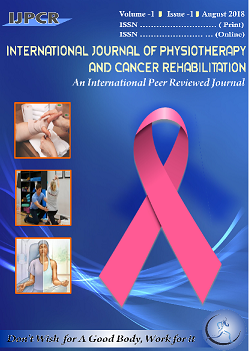International Journal of Physiotherapy and Cancer Rehabilitation
SEARCH
Our Founder
Popurlaly known as ‘jannu bhai’, the Late manishi’s vision, farsightedness and sacrifice have enabled us reach the stature we enjoy today More...Vice Chancellor's Message
It gives me immense pleasure to learn that the 1st volume of international journal of physiotherapy and cancer rehabilitation is being More...Cover Page Volume I Issue I
 .
.
IJPCR
Impact of Manipulation and Exercise Therapy on Sacroiliac Joint Dysfunction
Mukesh kumar ,Ph.D research scholar JJTU University and Principal Sriganganagar college of allied health sciences
Abstract:
Background:
The sacroiliac joint dysfunction (SIJD) has been found to be the primary culprit for lower back pain (LBP), but it is still overlooked and treated as LBP. There are no guidelines or appropriate therapeutic protocols for SIJD. Thus, there is a need for an effective treatment strategy for SIJD.
Health services should be orientated towards the prevention of secondary complications and the enhancement of the health status of stroke patients by encouraging a habitual lifestyle that involves health-promoting behaviors. A general health behavior curriculum should be provided as a service to all those living with physical disabilities. The objective of this study was to find out what are the health-related behaviors of stroke patients in various hospitals and health centers in the National Capital Region and what factors influence the engagement of the stroke patients in these health-related behaviors.
Objective: To compare exercise therapy (ET), manipulation therapy (MT), and a combination of the 2 (EMT) in terms of their effectiveness in treating SIJD.
Study Design: A comparative, prospective, single-blind randomized controlled trial.
Setting: Physiotherapy department, Tantia University, Sriganganagar, Rajasthan, India.
Methods: A total of 51 patients with lower back or buttock pain resulting from SIJD were randomly assigned to 1 of 3 study groups: ET, MT, or EMT. The ET group received posterior innominate self-mobilization, sacroiliac joint stretching, and spinal stabilization exercises. The MT group underwent posterior innominate mobilization and SIJ manipulation. Lastly, the EMT group received manipulation maneuvers followed by exercise therapy. Pain and disability were assessed at 6, 12, and 24 weeks after the interventions.
Results: All 3 groups demonstrated significant improvement in pain and disability scores compared to the baseline (P < 0.05). The difference among these therapeutic protocols was found to be a function of time. At week 6, MT showed notable results, but at week 12, the effect of ET was remarkable. Finally, at week 24, no significant difference was observed among the study groups.
Limitations: A major limitation of the present study is lack of a control group receiving a type of intervention other than the experimental protocols. Another limitation is the short duration of follow-ups.
Conclusions: Exercise and manipulation therapy appear to be effective in reducing pain and disability in patients with SIJD. However, the combination of these 2 therapies does not seem to bring about significantly better therapeutic results than either approach implemented separately.